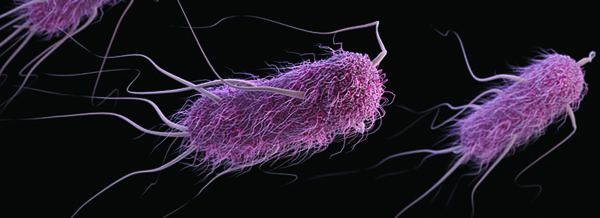
Bio Bites
By R. Gary Raham
A biologist-artist’s ruminations about our roles in a science-inspired world
The Rocky Mountains grow taller at about the speed of a growing fingernail. Complex animals and plants (including humans) change at a similar lethargic pace. They evolve from generation to generation as natural forces alter the genetic code that programs their development. Simple microbes, however, evolve on a fast track. Escherichia coli, an inhabitant of the human gut, completes a generation in 40 minutes. Richard Lenski, an evolutionary biologist at Michigan State University, has been watching E. coli grow for 31 years now—over 73,000 of their generations—and those microbes have taught him much about the evolutionary process that slowly shapes all the life on our planet.

Lenski’s Long-Term Evolutionary Experiment or LTEE began in 1988. He began by studying two populations of E. coli living in slightly different conditions. One population died out, but the other kept growing. He shifted the focus of his study to observe how twelve different colonies of the same bacterium living in exactly the same medium would change over time. His work has now become a foundational experiment in microbial evolution.
Each of the dozen flasks contains 10 milliliters (about 200 drops) of a solution composed of water, sugar (for food), and citrate (a compound allowing microbes to absorb iron) kept at a temperature of 370 C (98.60 F—or human body temperature). One drop (0.1 ml) of bacteria grow for 24 hours in each flask, producing about six new generations—the equivalent of human reproduction over 150 years. One drop from each flask at the end of the day is used to start twelve descendant colonies. After 75 days (roughly 500 generations), an entire 12-flask set is frozen. This provides “ancestral populations” that can periodically be compared to the latest iteration of bacteria. If human populations were similarly “frozen” every 500 generations, our last Instagram image would have been the set of nomadic hunters and gatherers that lived 12,500 years ago.
In the real world, mutations in DNA succeed or fail within an environment that is also changing—making it harder for scientists to find patterns. Lenski’s bacteria live in a boringly constant environment. The measure of success becomes growth. Faster growing cells will exist in greater numbers within the drop of liquid transferred to the next flask.
After more than 73,000 generations, 11 flasks of bacteria each contained a colony with a roughly 70% faster growth rate than the 1988 bacteria. But scientists were surprised to find that each colony arrived at their faster growth rate along unique biochemical pathways. The routes to faster growth depended on historical contingency. The speed of reproduction for each colony was dependent on a unique historical sequence of mutations in various biochemical pathways, each contingent on the changes that had come before.
What about flask number 12? In 2003, a student found a colony that had reproduced so fast overnight that the liquid had turned cloudy with cells. This colony—and only this colony—had discovered a way to turn citrate (the compound added to allow for iron uptake) into a food source. That particular sequence of evolutionary events never happened again.
Seventy-three thousand generations for humans would represent 1,825,000 years. That long ago, in our past, there existed a dozen or more hominins—creatures in our same genus that shared many of our social, tool-making, and physical skills. It makes one wonder what historical contingencies led to us—Homo sapiens—the “wise” species of ape who has turned the world cloudy with its own reproductive success.
See Lenski’s university website page at http://myxo.css.msu.edu/.
Support Northern Colorado Journalism
Show your support for North Forty News by helping us produce more content. It's a kind and simple gesture that will help us continue to bring more content to you.
BONUS - Donors get a link in their receipt to sign up for our once-per-week instant text messaging alert. Get your e-copy of North Forty News the moment it is released!
Click to Donate
